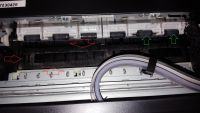WELCOME to forum users elektroda.pl
Recently I bought a used Epson PX730WD printer and at the beginning it was OK, but when I bought self-restarting cartridges and replaceable inks for aliexpres, two heads got stuck (LC and LM) and now if I would like to unclog them this model liquid is it enough that it will be only for EPSON printers?
I live in France and I found such a liquid for regenerating EPSON jet d'encre heads.
http://tiny.pl/g1l9k
Thank you in advance for your help.
And one more small question, can I clean the sponges on the guide under the head (see photo red arrows) and how to do it, pour cleaning liquid there, head and then drain with a paper towel?
And whether the rollers (photo green arrows) of paper feeding can also be cleaned because with a dense print, e.g. graphics, you can often see black spots.

and black spots on the printout.

I will add that if I set the printout in a smaller contrast, there are no stains but the image is less sharp.
Recently I bought a used Epson PX730WD printer and at the beginning it was OK, but when I bought self-restarting cartridges and replaceable inks for aliexpres, two heads got stuck (LC and LM) and now if I would like to unclog them this model liquid is it enough that it will be only for EPSON printers?
I live in France and I found such a liquid for regenerating EPSON jet d'encre heads.
http://tiny.pl/g1l9k
Thank you in advance for your help.
And one more small question, can I clean the sponges on the guide under the head (see photo red arrows) and how to do it, pour cleaning liquid there, head and then drain with a paper towel?
And whether the rollers (photo green arrows) of paper feeding can also be cleaned because with a dense print, e.g. graphics, you can often see black spots.

and black spots on the printout.

I will add that if I set the printout in a smaller contrast, there are no stains but the image is less sharp.


